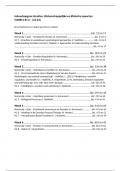College aantekeningen
Aantekeningen ALLE Hoorcolleges Emoties: Wetenschappelijke en Klinische Aspecten (500851-B-6) - 22-23
Aantekeningen van ALLE hoorcolleges en alle kennisclips (en canvas quizes) voor elke week voor het major/minor vak voor Klinische Psychologie, Emoties: Wetenschappelijke en Klinische Aspecten (500851-B-6). Aangevuld met samenvatting van enkele artikelen en boekhoofdstukken (Let op: een paar, niet a...
[Meer zien]




